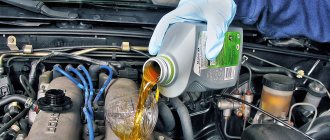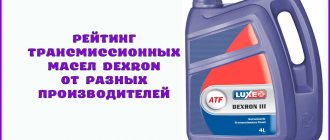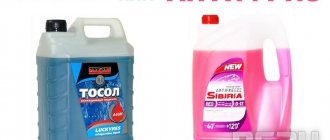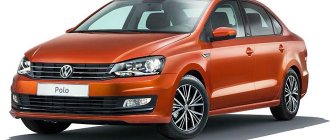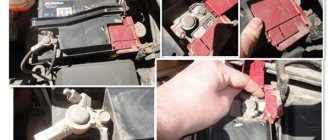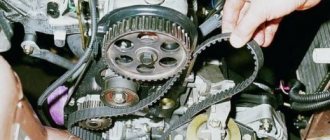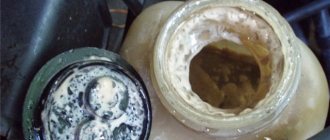Various coolants are used to cool the engine in order to improve its operation, and many drivers are concerned about whether it is possible to mix antifreeze and antifreeze. The fact is that for a long time antifreeze has been used as the most popular liquid, being practically the only representative on the market. In addition, car owners trusted domestic manufacturers more than imported ones. Therefore, in modern everyday life, when many drivers mention coolant, nothing more than antifreeze comes to mind.
Currently on the market you can find:
- acid-based element;
- salt composition.
Considering the composition, it can be noted that the product is based on ethylene and polypropylene. Ethylene products are more toxic, so the latter are gaining popularity, and they are bought by drivers who want to ensure safe driving on city roads and intercity highways.
What is the difference between antifreeze and antifreeze
More recently, the domestic automobile market was much more “modest” and offered exclusively one brand of engine coolant. It was developed back in 1971 and acquired the name “antifreeze”. By the way, this is an abbreviation for the name of the department of the research institute that deals with exactly this issue (“Organic synthesis technology”), and the ending “ol” determines whether it belongs to the group of organic alcohols. Subsequently, the name became a household name; it is still used by domestic manufacturers, although the initial composition has already been hopelessly changed. “Antifreeze” is a relatively new concept, at least for domestic car enthusiasts. This is an international designation for non-freezing liquid, because the literal translation sounds like “anti-frost”. Both concepts are used to varying degrees for marketing purposes; antifreeze is presented as an exclusively original and proven composition. On the antifreeze side is a spectacular name and positioning as an exclusively new and unique product, vital for the “health” of your car. Essentially, both liquids perform the same function. The main difference is in the composition and brand of the manufacturer, but there are also other selection criteria, which will be discussed later.
In what cases is it necessary to replace antifreeze?
After what period of time it is necessary to replace the coolant, it is usually indicated in the vehicle’s technical passport. If the owner uses a different variety, the timing should be found in the instructions for the product itself. Antifreeze and antifreeze can only be mixed when the test gives a positive result. However, it is best to flush the system and fill it with clean liquid.
Replacing the coolant may be necessary not only if it becomes dirty. For example, Japanese cars are initially filled with red antifreeze, which freezes at a temperature of -30 degrees. Therefore, in our Russian climate, such coolant often becomes inoperative and must be replaced.
Properties and signs of antifreeze
There are two main components in any coolant: ethylene glycol (propylene glycol) and water. Additional additives and dyes determine the characteristics and properties, as well as the areas of use of the substance. The following gradation is usually used:
- Class G 11 mineral compositions. Contain various combinations of silicates, phosphates and other compounds. They form a thick hard layer on the walls of the cooling system, which impedes heat transfer. Designed for a service life of up to two years, after which a complete fluid replacement is required. For ease of identification, they are painted blue or green.
- Class G 12 organic substances. Carboxylic acid is used as additives. It acts exclusively in areas of corrosion, forming a thin protective layer. These are more advanced compositions, the main drawback of which is the lack of preventive protection (the components are activated only after corrosion is “detected”, and do not protect against it). The service life of such liquids is 3-5 years. They come in a wide range of colors: from yellow to purple.
- Class G 12+ and G 12++ are combined mixtures based on carbide acids and silicates. They do not have the disadvantages of previous compositions, are called hybrid and can last up to 5-7 years. Also painted in yellow-red-lilac tones.
- Class G 13 based on propylene glycol. This is the most modern and non-toxic type of coolant today. They do not have a clear gradation in color, usually pink or purple.
Mineral additives, of which only 5-7% of the total volume, play a major role in the composition of the coolant. They provide corrosion protection, prevent the destruction of rubber seals and other important functions. The “recipe” from different manufacturers may differ significantly, so the compositions of different brands should not be mixed or changed at your own discretion.
It is also believed that for a copper or brass radiator, only compounds with a carboxylate base should be used. In turn, aluminum heat exchangers work better on liquids of silicate origin. Hybrid antifreezes are universal, so they are suitable for any type of car.
Why are these coolants mixed?
In the post-Soviet space, Tosol liquid was very common for engine cooling. Firstly, this antifreeze was almost the only one sold in auto stores, and secondly, domestic drivers at that time still trusted their manufacturer more than a foreign one. Therefore, in conversations with experienced motorists, refrigerants are still called “antifreeze.”
Today you can find two types of coolant (coolant) on sale:
- salt-based refrigerant (can be blue or green);
- acid based refrigerant (red).
As for the composition, the basis of any coolant is ethylene or polypropylene glycol. Since ethylene antifreezes are more toxic, polypropylene glycol coolants have recently become increasingly popular.
Why interfere with the coolant? Each driver answers this question differently. For example, if there is a leak in the cooling system and the antifreeze is leaking, then the driver has to buy a different brand of coolant so as not to stall somewhere on the road. So, liter by liter another refrigerant is poured in and the compositions are mixed.
Some “garage specialists” advise car enthusiasts to mix the coolant so that there are more additives in the system. In their opinion, this will protect the system from the effects of corrosion and decay of particles in the consumable material, but this is far from the case. This is especially true in winter. In the summer, instead of coolant, you can even fill the system with water if there are no other options, but before the onset of cold weather it must be changed, otherwise:
- the water will freeze in any case at sub-zero ambient temperatures;
- if the frost is severe, the expansion tank will crack under the influence of ice;
- The cooling system pipes may also crack at the joints, and this will be very difficult to detect.
Is it possible to do this and what will happen?
Is it possible to mix Tosol with antifreeze, and what will happen if you do this? This question has probably been asked by every vehicle owner. We will try to answer this question.
First, you need to understand that you should not navigate the coolant by color, as is customary among domestic motorists. They do not need to be divided into “Antifreezes”, red and green antifreezes. When mixing, their composition is important, and color plays a secondary role. We will talk about this further. When mixing coolant, it is important to familiarize yourself with the composition of the substance being poured and the consumable being poured.
Also, do not forget that any refrigerant is a mixture of a base (polypropylene glycol or ethylene glycol) with water, dyes and all kinds of additives.
Each auto manufacturer uses a specific package of additives, and even in the line of one manufacturer, refrigerants may differ in composition and amount of additives. They can be:
- anti-corrosion;
- anti-foam;
- additives to prevent the effect of antifreeze on the rubber elements of the cooling system.
And there are a lot of types of such additives. Therefore, when mixing coolant, it is necessary to take into account the characteristics of each car, as well as the composition of the liquid, so that you do not end up with a “mix” of additives.
If you are still asking the question “is it possible to mix Tosol and antifreeze?”, then we will answer unequivocally: in fact, there is nothing wrong with this if the coolants have the same composition.
For example, coolant from a domestic manufacturer is more aggressive towards the channels of the cooling system. Because of this, silicate is added to it, which settles on the walls of pipes and other elements and protects them from corrosion. Traditional antifreeze does not have such a destructive effect on the cooling system, so silicate is not added to it. But it contains other additives.
Spoiled brown refrigerant
If you mix antifreeze with Antifreeze or change one consumable element to another with a different composition, then it is better to do this with a complete flushing of the cooling system. Otherwise, the metal components of the system may corrode or sediment may form in the system, which will clog the channels and degrade the properties of the refrigerant as a whole. That is why mixing these two types of liquids with different compositions is best done as a last resort.
It is quite possible to mix Antifreeze and antifreeze if these refrigerants have the same composition but different colors.
Now let's talk about color. The color of a substance means that it is possible to mix liquids of the same color, but from different manufacturers. For example, red refrigerants can be mixed with red antifreeze - in this case, it is guaranteed that the liquid will not foam in the system and will not form a sediment that will clog it.
Which refrigerants are not sensitive to mixing? These are liquids of the “G12”, “G12+” and “G11” standards. The colors of these coolants can be yellow, blue, red, green. “G12” consumables can be safely mixed with each other (meaning different industries) and with “G 11” liquids.
How to find out if you can mix antifreeze and antifreeze
Most car enthusiasts do not accept mixing any technical fluids. Of course, this is the most correct and correct step, as is the use of compounds recommended by the manufacturer of your car. At the same time, there are unforeseen situations when you have to act at your own peril and risk. In this case, you should adhere to the following rules. How to ensure optimal mixing of liquids:
- Use products from the same manufacturer. Often the same composition can be “hidden” under different labels.
- Focus on the characteristics and classes of different manufacturers. This is a more correct, although not ideal, choice.
- Antifreeze of proven quality (not counterfeit) can be used to mix class G 11 antifreeze. For other classes this is unacceptable.
- In some cases, orientation by the color of the liquid will help, but recently these standards have often begun to be violated, so an incompatible result is possible.
- It is relatively safe to mix substances of class G 11 or G 12 with similar compounds labeled G 12+ and G 12++. As mentioned earlier, these mixtures are hybrid, which means they contain active components from previous developments in varying concentrations. It is not recommended to make a hybrid by mixing G 11 and G 12 yourself, because the result may not be at all as expected.
- Diluting class G 13 antifreeze with any other is impractical and simply pointless. In the gradation of coolants it occupies a privileged place, including in terms of cost.
It should be noted that this is a force majeure situation that is permissible for a short period. If necessary, be sure to drain the “cocktail” from the system, rinse it with distilled water and fill it with the mixture recommended in the manufacturer’s instructions.
A little history
In order to understand in which cases antifreeze and antifreeze can be mixed and in which not, it is worth knowing about the history of coolants. At the dawn of the development of the automotive industry, plain water was poured into engines, many of whose parts were made of cast iron. In winter, ethylene glycol was added to it in order to prevent freezing. With the invention of more complex engine designs, manufacturers had to develop more advanced coolant formulations. The fact is that water with ethylene glycol literally corroded new steel engine components, provoking corrosion processes.
View gallery
What problems will arise when mixing?
Many motorists, especially those of the old school, often use the principle of mixing “proven” antifreeze with newfangled antifreeze. There also seems to be a reasonable explanation: adding antifreeze to antifreeze means improving its properties with additional additives, and ultimately saving significantly on the purchase of coolant. The logic is ironclad, but sometimes it malfunctions and the entire system has to be repaired. The situation that will happen if you add antifreeze to antifreeze can be described as a lottery. Many people do this all the time and never encounter problems with the engine, and for some, the first time becomes the last and entails expensive repairs and additional costs. The most common type of failure is the loss of solid sediment particles. This happens when two liquids of different compositions are mixed, and without special chemical education it is impossible to predict the result of such experiments. In this case, the internal walls of the cooling system are damaged by abrasive particles, which leads to incorrect operation, clogging and damage to the fasteners.
What is better to use - domestic or imported coolant?
Imported antifreeze, as already mentioned, is more gentle on the engine. Therefore, it is still better to use it. However, domestic antifreeze, and especially when poured into Russian cars, can show far from the worst side. In addition, such liquids are often much cheaper than imported ones. Thus, what to pour - antifreeze or antifreeze into the engine of his car - must be decided by the car owner himself. Of course, using a domestic product to cool the engine of an expensive foreign car is a rather unique solution.
View gallery
But for an old VAZ-2107, antifreeze is quite enough.
When purchasing imported products, you should pay attention to the manufacturer. It is best to purchase antifreeze from a trusted company with a good reputation. People should not buy products from little-known companies. After all, the engine is the heart of the car, and everything connected with it should be treated carefully.
Tips for switching from antifreeze to antifreeze and vice versa
If the information that mixing antifreeze with antifreeze does not convince you, you can use the following recommendations. In our article they are presented as a lifeline just in case (breakdown on the road, inability to buy the original composition). What to do in such cases:
- Once again, carefully re-read the list of recommended manufacturers of formulations. They may have a different designation from the given classes. In this case, information from the company’s official website or tips from the Internet will help.
- When switching to another type of coolant, you should definitely drain the remainder from the system, rinse it well with distilled water, and only then use the purchased mixture. If this is not done, there is a high probability of chemical reactions between substances, the result of which is difficult to predict.
- It is traditionally believed that antifreeze is a less aggressive liquid, suitable for careful operation of a car. Antifreeze is endowed with a simply magical ability to instantly corrode the walls of pipes and tanks. By the way, there is a completely opposite opinion. In this case, there will be only one answer: if this type and composition of the fluid is not suitable for use in your car, a negative result will be a matter of time. Different types of metal can react completely differently to the composition of the product, so what will be very useful and “tasty” for one radiator will be certain death for another.
What are coolants, their types and composition, and whether it is possible to mix antifreeze with antifreeze, because this option is often used and is even given as advice by experienced car enthusiasts on forums. All these questions are discussed in our information.
What happens to raw water when mixed with boiled water?
Essentially, mixing boiled water with raw water will simply result in unboiled water again in all its properties, which are important for its consumption by humans. If unboiled water from a particular source may contain bacteria and viruses, they will be transferred to the boiled water when mixed. Yes, their concentration will drop, but a small amount of unboiled water containing them will be enough to spoil a large amount of boiled water. That is, from a microbiological point of view, you cannot mix raw water with boiled water for the same reason that you cannot simply drink raw water.
From the point of view of the composition of impurities in water, their concentration decreases during boiling. Chlorine comes out with steam when water is heated, various elements settle in the form of scale on the heating elements. Therefore, mixing boiled water with unboiled water will simply lead to the fact that the composition of the final mixture will turn out to be more similar to the composition of unboiled water; elements that could have been completely released during temperature treatment will appear in it again. It turns out that from the point of view of the chemical composition of impurities in water, mixed boiled water with unboiled water will be more similar to unboiled water.
That is, from a scientific point of view, nothing bad will happen when mixing, it’s just that the mixed water will actually be unboiled with all the ensuing consequences. For some sources of water, drinking it raw is dangerous, for others it is quite safe, for example, if it is tap water. If you use filtered or bottled water, then there will be no negative consequences. Believe less in unfounded rumors and choose your water sources more carefully!
What is the difference between different colors of antifreeze?
What is the difference between antifreeze of blue, green, red colors and brands G11 and G12?
To understand the question of what kind of coolant can be filled, and whether mixing them is allowed, it is worth knowing the features of antifreeze types G11 and G12.
Here's what you need to know:
G11.
Inorganic antifreezes are called glycol. The liquid base contains corrosion inhibitors that form a protective film on the inside of the engine elements.
Such additives are useful in cases where the coolant comes into contact with non-ferrous metals.
If there is no protective film on the surface, then the metal is destroyed due to the action of the glycol base.
G11 compounds last for 2-3 years, after which they require replacement.
The first representative of such antifreeze was a coolant called VW coolant G11 (manufactured by Volkswagen).
At the present stage, the company produces “hybrid” coolants under this brand, which are produced according to the following specification - VW TL 774-C.
As for other manufacturers, they follow the path of the founder, but it is not always possible to strictly follow the stated requirements.
Thus, the original G11 antifreeze does not contain phosphates, amines or borates.
As for G11 coolants from other manufacturers, they usually contain these additives. The color of the products is most often green.
G12.
Coolants that belong to the category of carboxylate antifreeze.
The already mentioned Volkswagen company previously released the product VW coolant G 12, after which it developed a specification corresponding to the new coolant (its name is VW TL 774-D).
Unlike the G11 discussed above, the twelfth type has a different effect on the motor.
It is no secret that modern power units are made without the use of copper and brass, and the main sources are steel and aluminum.
During operation, corrosive films are created on the surface of these metals, which lead to gradual destruction of engine parts.
Additives in G12 eliminate the appearance of such deposits. The new technology used in the production process is called Long Life. The advantage is that the coolant lasts longer.
But you can completely switch to a new composition only if there are no non-ferrous metals in the engine. Otherwise, G12 additives will destroy the surface.
The color G12 is usually red (less often yellow).
What happens if you mix antifreeze with antifreeze?
Firstly, the question is why mix these two different refrigerants. Well, various circumstances happen on the road, for example, there is an antifreeze leak and after eliminating the leak, you need to add antifreeze. But there is not always a canister of antifreeze in the trunk, and here they sell antifreeze nearby on the side of the road. You have to buy it and top it up to continue moving forward.
Or, as often happens, sooner or later after buying a used car, you have to top up the coolant, and then the driver asks the question: what was filled in before? Color is easy to determine, but classes are difficult. In such cases, experts recommend, again, not to save, but to drain the old fluid and fill in the new one in full. It is even possible that the old one has expired.
But, let's look at what happens after adding antifreeze to antifreeze.
From the composition we know that they only have in common water and, perhaps, a standard (ethyl alcohol). And each manufacturer adds different additives and additives in different quantities. Therefore, when mixing antifreeze and antifreeze, a sediment may form that will settle in the channels and on engine parts, which will gradually reduce the life of the internal combustion engine. Nothing bad will happen when adding antifreeze to antifreeze if their components are basically the same, but this cannot be checked with your own hands without a chemical laboratory.
Based on the above, we conclude that if you already had to mix antifreeze and antifreeze, then upon arrival, it is better to drain this liquid, do a complete flush of the engine cooling system and fill in a new homogeneous mixture. The cost of buying new antifreeze will save you a lot of money, effort and time.

